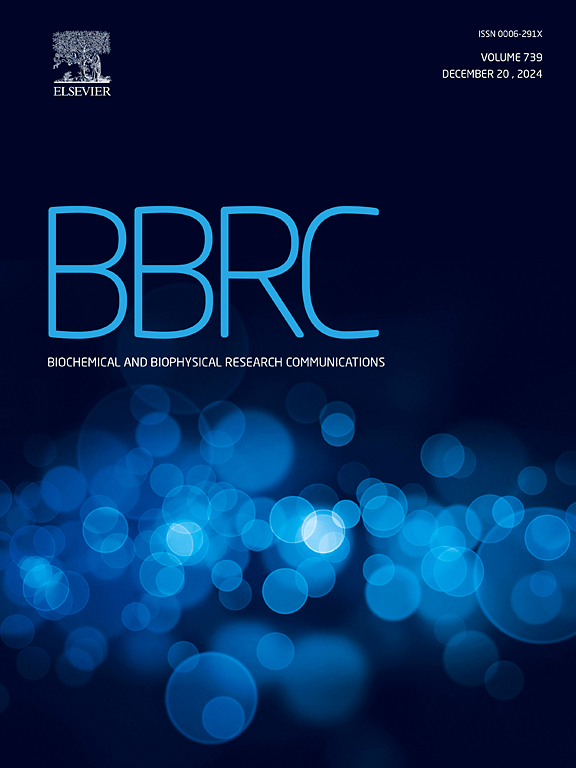Unlocking conformational dynamics of SapA: insights into the emphasis of ligand dependency using molecular dynamics simulation
IF 2.2
3区 生物学
Q3 BIOCHEMISTRY & MOLECULAR BIOLOGY
Biochemical and biophysical research communications
Pub Date : 2025-07-05
DOI:10.1016/j.bbrc.2025.152304
引用次数: 0
Abstract
The Sap transport system belongs to an ATP-binding cassette importer, which is reported to render resistance against host-produced antimicrobial peptides (AMPs) amongst various Gram-negative bacteria. The Sap system imports the AMPs across the membrane into the cytoplasm, wherein they are cleaved by the proteases. The Sap system comprises five components: a substrate-binding protein (SBP, SapA), two transmembrane domains (TMDs, SapBC), and two nucleotide-binding domains (NBDs, SapDF). Interestingly, the membrane components (SapBCDF) of the Escherichia coli Sap (EcSap) system were suggested to function as a putrescine exporter. On the contrary, recent in silico reports suggested its multifaceted attributes in the uptake of dipeptides, AMPs, and heme. To establish the multifarious nature, extensive molecular dynamics simulations of EcSapA in its apo and holo (bound to dipeptides, AMPs, and heme) forms were performed to gain structural insights into its molecular plasticity. The results of this study suggest that EcSapA possesses a wide and promiscuous binding site that is favorable for accommodating varying lengths of ligands with a ligand-dependent conformational dynamics mechanism. Further, the estimated binding energies of the ligands suggest that EcSapA shows a preferential binding for cationic AMPs, followed by heme and dipeptides. In summary, the study highlights the ligand-binding dynamics within the promiscuous binding site of EcSapA, enlightening a lucrative target for drug development.

解锁构象动力学的SapA:洞察到配体依赖的重点使用分子动力学模拟
汁液转运系统属于atp结合盒进口商,据报道,在各种革兰氏阴性细菌中,它对宿主产生的抗菌肽(amp)产生耐药性。汁液系统将amp穿过膜进入细胞质,在那里它们被蛋白酶裂解。Sap系统包括五个组成部分:一个底物结合蛋白(SBP, SapA),两个跨膜结构域(TMDs, SapBC)和两个核苷酸结合结构域(NBDs, SapDF)。有趣的是,大肠杆菌液(EcSap)系统的膜组分(SapBCDF)被认为具有腐胺输出器的功能。相反,最近的硅报告表明其在摄取二肽,amp和血红素方面的多方面属性。为了确定EcSapA的多样性,我们对其载脂蛋白和holo(与二肽、amp和血红素结合)形式进行了广泛的分子动力学模拟,以获得其分子可塑性的结构见解。本研究结果表明,EcSapA具有广泛且混杂的结合位点,有利于适应不同长度的配体,具有配体依赖的构象动力学机制。此外,对配体结合能的估计表明,EcSapA优先结合阳离子amp,其次是血红素和二肽。总之,该研究突出了EcSapA混杂结合位点内的配体结合动力学,为药物开发提供了有利可图的靶点。
本文章由计算机程序翻译,如有差异,请以英文原文为准。
求助全文
约1分钟内获得全文
求助全文
来源期刊
CiteScore
6.10
自引率
0.00%
发文量
1400
审稿时长
14 days
期刊介绍:
Biochemical and Biophysical Research Communications is the premier international journal devoted to the very rapid dissemination of timely and significant experimental results in diverse fields of biological research. The development of the "Breakthroughs and Views" section brings the minireview format to the journal, and issues often contain collections of special interest manuscripts. BBRC is published weekly (52 issues/year).Research Areas now include: Biochemistry; biophysics; cell biology; developmental biology; immunology
; molecular biology; neurobiology; plant biology and proteomics

 求助内容:
求助内容: 应助结果提醒方式:
应助结果提醒方式:


